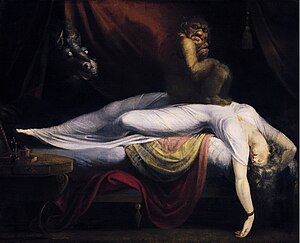Sleep paralysis
| Sleep paralysis | |
|---|---|
 |
|
| The Nightmare, by Henry Fuseli (1781) is thought to be one of the classic depictions of sleep paralysis perceived as a demonic visitation. | |
| Classification and external resources | |
| Specialty | Sleep medicine |
| DiseasesDB | 12182 |
| MeSH | D020188 |
Sleep paralysis is a phenomenon in which an individual, either during falling asleep or awakening, briefly experiences an inability to move, speak, or react. It is a transitional state between wakefulness and sleep. It is often accompanied by terrifying hallucinations to which one is unable to react due to paralysis, and physical experiences (such as strong current running through the upper body). These hallucinations often involve a person or supernatural creature suffocating or terrifying the individual, accompanied by a feeling of pressure on one's chest and difficulty breathing. Another common hallucination type involves intruders (human or supernatural) entering one's room or lurking outside one's window, accompanied by a feeling of dread.
Genetics and sleep deprivation are a major cause of sleep paralysis, and it has also been linked to disorders such as narcolepsy, migraines, anxiety disorders, and obstructive sleep apnea. Sleeping in a fixed supine position increases the chance of sleep paralysis. The underlying mechanism is believed to result from disrupted REM sleep, when there should be a general inability to move muscle to prevent the sleeper from acting out their dreams. About 8% of people experience sleep paralysis at one point in their life.
Sleep paralysis is closely related to REM atonia, the paralysis that occurs as a natural part of REM (rapid eye movement) sleep. Sleep paralysis occurs either when falling asleep, or when awakening from sleep. When it occurs upon falling asleep, the person remains aware while the body shuts down for REM sleep, a condition called hypnagogic or predormital sleep paralysis. When it occurs upon awakening, the person becomes aware before the REM cycle is complete, and it is called hypnopompic or postdormital. The paralysis can last from several seconds to several minutes, with some rare cases being hours, "by which the individual may experience panic symptoms" (described below). As the correlation with REM sleep suggests, the paralysis is not complete: use of EOG traces shows that eye movement is still possible during such episodes; however, the individual experiencing sleep paralysis is unable to speak.
...
Wikipedia
